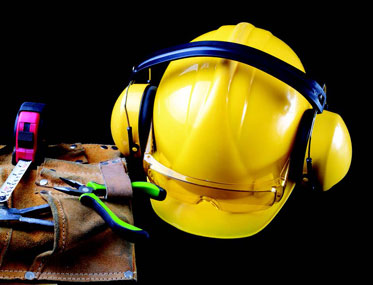If you work in construction, noise-induced hearing loss (NIHL) is an occupational hazard. But unlike the loss of life or limb, damage to your ears usually occurs gradually and painlessly, and in many cases without you even noticing.
Much to the frustration of audiologists the world over, hearing damage in this sector is entirely preventable when properly designed ear personal protection equipment is correctly fitted to keep industrial noise well below harmful levels.
CHOOSING THE RIGHT PROTECTION
To give yourself the best possible chance of protecting your hearing while working on a construction site, it is important to invest in appropriate hearing protection devices for the work you are undertaking.
The most commonly used hearing protection devices include in-the-ear options such as disposable foam earplugs, push-to-fit earplugs and reusable earplugs. Over-the-ear options include earmuffs or banded hearing protectors.
Some workers even choose to use two devices together. However, it’s vital to correctly assess your hearing protection as using non-electronic devices can result in losses in situational awareness as well as broader communication difficulties.
The individual fit of personal hearing protectors is also of critical importance, as is ensuring your personal hearing protection devices are regularly inspected to ensure their integrity has not been compromised.
When looking to purchase hearing protection for job sites, one of the most important considerations is the comfort of your chosen hearing protection. The size and shape of your ear canal will play a big part in determining the size of the earplug you choose as well as the material it is constructed from.
When deciding which type of hearing protector to choose, it is best to try one or more different models for an extended time to ensure the right fit. Those who opt to use earmuffs may find the pressure of the headband to hold the ear cups firmly in place may take a bit of modification to get right. If the pressure is excessive in either case, it can make wearing the hearing protector uncomfortable.
Other things to consider are the softness and weight of your chosen protection and your specific work conditions.
HOW HEARING LOSS OCCURS
Loss of hearing occurs as a result of nerve destruction or damage to hair cells that transfer sound waves within the ear. It can occur suddenly if a person is exposed to a very loud sound, blast or impulse described as acoustic trauma.
Safe Work Australia says the degree of hearing loss that occurs is dependent on how loud the noise is, how long someone is exposed to it and, to some extent, individual susceptibility.
It says the frequency or pitch can also have some effect on hearing loss, since “high-pitched sounds are more damaging than low-pitched ones”.
In almost all cases, hearing damage as a result of excessive noise exposure in industrial settings is irreversible.
EFFECT ON OVERALL HEALTH
NIHL has been linked to many different health conditions including dementia, stress, hypertension, tinnitus (ringing in the ears) and psychiatric disorders. And the news only gets worse.
A study of more than 6300 workers in the US found workers who are persistently exposed to excessive occupational noise may be two to three times more likely to suffer from serious heart disease than those not exposed.
It is estimated more than 1.1 million employees in Australia may be potentially exposed to hazardous levels of noise at work. The evidence for this is the number of workers compensation claims made, with more than 16,000 successful claims for industrial deafness involving hearing approved between 2002 and 2007 (the most recent statistics available), equating to more than 3000 workers annually.
FOLLOW THE RULES
Those who work in construction in Australia are required to adhere to a strict code when it comes to industrial noise exposure to secure the health and safety of both workers and workplaces.
The Australian Standard AS/NZS 1270:2002 rates hearing protection into five classes. Class 1—less than 90 dB(A)—is the lowest level of protection and Class 5—between 105 dB(A)—is the highest level.
To put this into perspective, the typical sound level of a normal conversation is around 60 dB(A), a front-end loader 85, a lawnmower 90, a chainsaw 110 and a rock drill 120. Noise levels greater than 140 dB(C) usually occur with impact or explosive noise such as sledgehammering. Any exposure above this peak can cause almost instant hearing damage.
Whether the exposure standard 85 dB(A) averaged over eight hours is exceeded depends on the level of noise involved and length of exposure.
Without hearing protection at a noise level of 80 dB(A) (equivalent to the level of noise you would hear in heavy traffic), the exposure time before the standard is exceeded is 16 hours.
However, at a noise level of 127 dB(A)—which is equivalent to the level of noise you would hear when using a rivet hammer—the exposure time before the standard is exceeded is just 1.8 seconds.
WHAT ELSE YOU CAN DO
Broadly speaking, there are a number of ways to eliminate at source or minimise your exposure to noise and long-term hearing damage.
● Wear adequate protection.
● Choose and use equipment that doesn’t make as much noise.
● Change your engineering controls by fitting exhaust mufflers on internal combustion engines, fitting silencers to compressed air exhausts and blowing nozzles, and installing vibration minimising seats on mobile plants.
● Employ job rotation to limit the time you spend in noisy areas or to ensure that noisy work is done when fewer workers are present.
● Adopt adapting techniques such as bending metal in a vice or a press rather than hammering it into shape, welding two pieces of metal together rather than riveting, and gluing wood together rather than hammering in nails.
Always remember it is never too late to protect your hearing, even if it is already partially damaged. Hearing protection will help conserve any hearing ability that remains.





